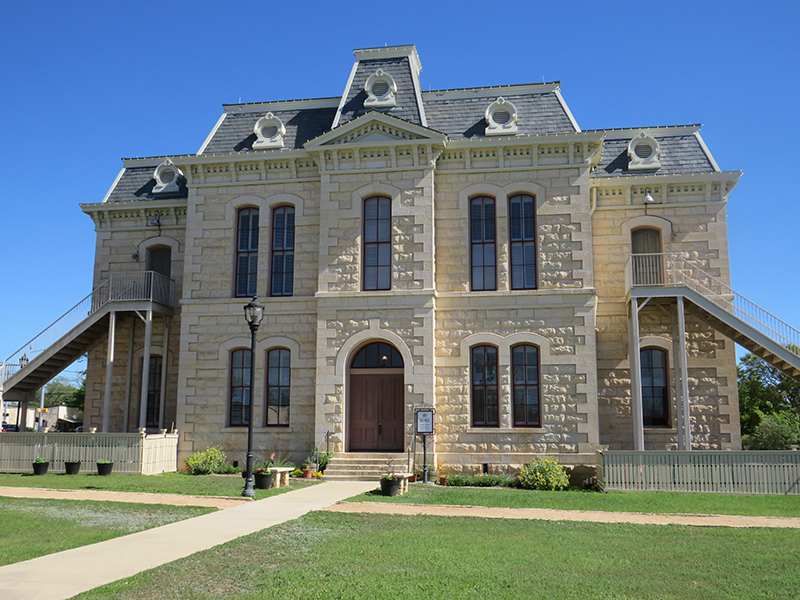A building can be more than a shelter. A building can develop a character and a spirit all its own. The people of Mason County found out how important a building can be when their courthouse burned in 2021. The fire gutted the interior. The roof collapsed. By morning, only the outside walls and the columns stood upright. Citizens stared in disbelief at the smoldering shell, trying to sort out their emotions. They took some comfort in knowing that the courthouse had been scheduled for renovation and all county records had been moved, but the building that had stood tall since the days of their great-grandparents had been torched.
Michaela Martinez saw the blaze that night. “It was painful to watch,” she said. “I felt helpless. I just stood there with the others not knowing what to do.” Chelsa Armendariz, a deputy clerk at the courthouse saw the scorched rubble in the daylight. “I was in shock as much as anything else,” she remembered. “I felt like I had lost something.”
People who have spent their lives in the city may not understand what a courthouse means to a small Texas town. “Functionally, a courthouse is little more than a mixed-use government office building,” architect and author Brantley Hightower explained, “and yet it often serves as the physical and symbolic heart of its community.”
The attachment between small town people and their courthouse has its roots in the relationship between Texans and local government. State and federal governments are distant, but local government, especially in rural areas, is intimate and personal. Small town people know the mayor, the sheriff and the county judge. While the courthouse is a daily presence in small towns, it is also a constant reminder of history. A small-town courthouse connects the present with the past. It tells a story written in mortar and stone. A courthouse symbolizes the values and beliefs of the people who built it.
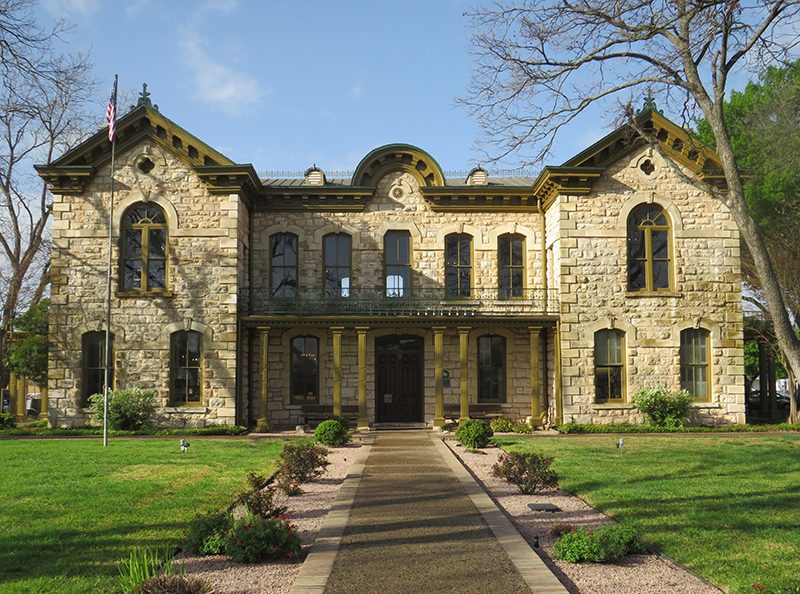

Many Texas courthouses went up in the late 19th century. They projected an image of prosperity, law and order and the end of the wild west. Counties built courthouses to make a statement, even if those counties had to stretch the truth and the budget to do it.
“When many of these courthouses were built in the late 1800s and early 1900s,” Hightower noted, “Texas was still a relatively poor, rural state. And so when a county invested so much time and money to construct an ornate ‘temple of justice,’ it wasn’t a reflection of existing conditions so much as it was a fiction of what the people wanted their community to become.”
Frontier towns knew the significance of a courthouse and the power it represented. When the state of Texas first formed counties in the 19th century, some towns fought skirmishes for the right to be the county seat. In Blanco County, Johnson City wrestled the county government away from the town of Blanco but not before both sides burned a little gun powder.
Look closely at an old courthouse, and history comes alive. Weathered handrails, stone steps worn smooth by decades of foot traffic and even bullet holes testify to a century or more of use and abuse. And while courthouses projected the promise of a bright future, many of them gave a wink to the past. There is rumor that many Texas courthouses face south – a deliberate nod to the old confederacy.
Beyond the symbolism of style and form, a courthouse is a treasure-trove of information about the county and the people who live there. Chances are if you have spent any time at all in a particular place, the county courthouse will have a record of that stay. The courthouse is a repository for everything from car titles to cattle brands. There are no secrets at the courthouse. Ever been arrested, sued or divorced? Somewhere a courthouse has a record of it. Birth certificates, marriage licenses, deed records and death certificates are methodically filed there and are available for public viewing.
Texas courthouse architecture not only reflected local tastes, aspirations and values, it mirrored trends in international design. Those courthouses built in the late 19th century tended to be Romanesque or Italian Renaissance styles. Many courthouses of that period, like the Kendall County Courthouse in Boerne and the old Gillespie County Courthouse in Fredericksburg, used elements of both styles. By the early 1900s architectural trends favored a new style for public buildings. The Beau Arts School of architecture combined the classic forms of Greece and Rome with French and Baroque influences. The Beau Arts style has been described as “a decorative motif within a classical form.” The Blanco County Courthouse in Johnson City and the Kerr County Courthouse in Kerrville are examples of the Beau Arts style. By the 1930s the sleek, streamlined contour of Art Deco became popular. Art Deco is balanced, symmetrical, machine-age elegance often with Mayan and Egyptian influences. The 1936 Gillespie County Courthouse in Fredericksburg reflects that style.

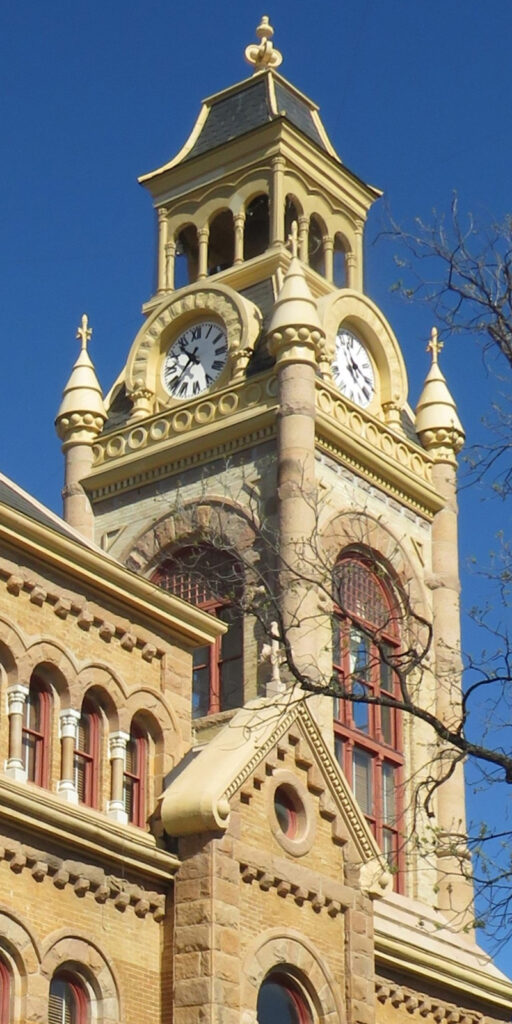
Georgia architect Edward Columbus Hosford designed the 1909 Mason County Courthouse in the Beau Arts style. It is the third building to house the county government in Mason. The first courthouse and all the county records burned in 1877, a victim of the Hoo Doo War. The fire may have been deliberately set. In the old days outlaws burned quite a few Texas courthouses to cover up crimes and destroy evidence. The rectangular shape and Doric columns of the Mason County Courthouse give it the look of a southern plantation. A brilliant white center dome and clock tower rise above the roofline. The building sits dispassionately in the middle of a rectangular town square as the constant motion of traffic and everyday business whirls around it.
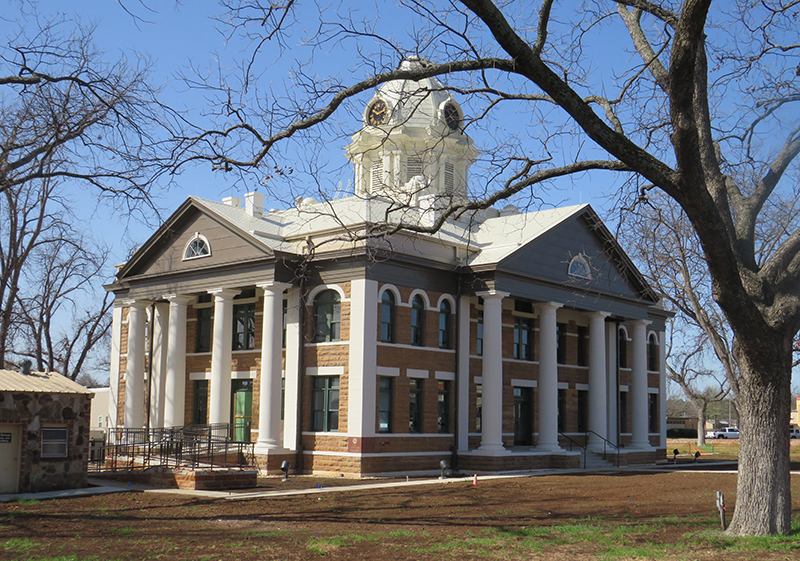
While the overall look of the Mason County Courthouse is straight out of “Gone With The Wind,” the design contains a mixture of elements typical of the Beau Arts style. The building features a low-slung Italianate roofline, Roman arches over some of the windows on the second floor and columns at each of the four entrances with gabled porticoes in the Greek Revival style.
The Mason County courthouse will reopen this summer, three years after the fire destroyed it. Contractors restored the building to its original specifications. Before the fire, the courthouse had a special place in the heart of Mason County. Here’s hoping the people of Mason find that same spirit and character when they throw open the doors to the renovated courthouse later this year.
Blanco County Courthouse – Texas law in the 19th century directed that the county seat had to be within five miles of the geographic center of the county unless two thirds of the voters voted otherwise. Officials wanted the seat of county government to be no more than a day’s ride from anywhere in the county so that all citizens had convenient access to it. In 1858, the state of Texas formed Blanco County from parts of several surrounding counties. The town of Blanco, at the time near the geographic center, became the county seat. Then in 1862 Blanco County lost a large area of land when the legislature formed neighboring Kendall County. As a result of that border realignment, the town of Blanco no longer occupied the geographic center of the county.
Johnson City took advantage of that technicality and forced a vote to move the county seat from the town of Blanco to the more centrally located town of Johnson City, 15 miles to the north. The first vote failed, but Johnson City didn’t give up. The dispute split the county. Tempers flared. Johnson City eventually won the vote although gunfire left one man dead and one wounded. When asked how the smaller town of Johnson City prevailed in the election, an old resident of Blanco stated, “the dead came out to vote.”
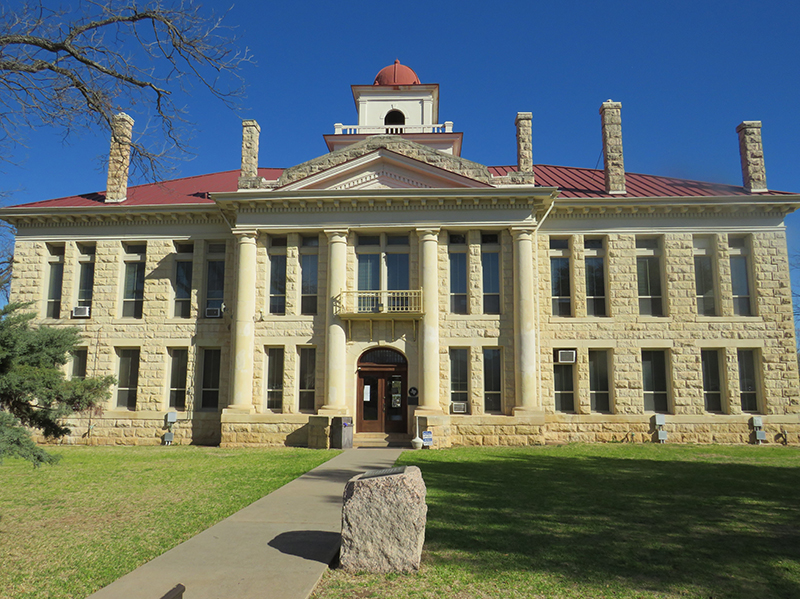
Frederick Ernst Ruffini designed the old Blanco County Courthouse in the former county seat of Blanco. Built in 1886, the building looks straight out of Hollywood. It oozes charm and character. Filmmakers shot the courtroom scenes from the Jeff Bridges movie “True Grit” there in 2010. Blanco County built the courthouse in Johnson City in 1916. On the outside the Beau Arts building looks like Versailles on a much smaller scale. Today the Blanco County Courthouse in Johnson City is famous for its Lights Spectacular display every Christmas.
Kerr County Courthouse – When the state formed Kerr County in 1856, the shingle-making village of Brownsborough on the Guadalupe River changed its name to Kerrville and became the county seat. That year Kerr County built its first log courthouse, 16 feet long and 8 feet wide, with sawed rafters, shingle roof and gabled ends. The county paid $100 for the building. Kerrville grew slowly in those early years, and in 1860 the county seat moved to Comfort, a more established community a few miles to the east. Two years later, when Comfort became a part of the newly formed Kendall County, the seat of government moved back to Kerrville. The current Kerr County Courthouse, built in 1926, sits on the corner of Main Street and Sidney Baker. The building has a restrained Beau Arts flavor.
Kendall County Courthouse – The state of Texas formed Kendall County in 1862, the only Texas county organized during the Civil War. Voters selected the town of Boerne, named for German poet, historian and political refugee Ludwig Boerne, as the county seat. The courthouse in Boerne, built in 1870, is the second oldest courthouse in Texas after the Cass County Courthouse in Linden. Kendall County paid $3,285 for the original one-story building but added a second story in 1886. The English architect Alfred Giles, who owned a ranch near Comfort, designed a new façade for the courthouse in 1909. Typical of Giles-designed buildings, the façade features elements of Romanesque, Italianate and other architectural styles.
Gillespie County Courthouse – Alfred Giles designed a new courthouse for Gillespie County in 1882. Built of local limestone, the building is simple and balanced with elegant features that represent a blend of architectural styles. The arched windows, thick stone walls and symmetrical design are Romanesque. The pronounced eaves supported by elaborate corbels and low-pitched roof are Italianate. By the1930s, the county needed more office and storage space and began the discussion of a new and larger courthouse. In May 1938 voters rejected a $150,000 bond issue. Then in June the Works Progress Administration in Washington offered the county a $65,450 grant for a courthouse which amounted to 45 percent of the projected total cost. In August 1938 voters approved a bond for the remainder of the funds needed for construction.
Local architect Edward Stein designed the 1936 Gillespie County Courthouse in the Art Deco Style. The outside walls are buff-colored brick although the base is red-granite – a material familiar to Gillespie County. Stein designed the similarly styled Fredericksburg National Bank Building on East Main Street (today Circle E Candles). In 1967, Mr. and Mrs. Eugene McDermott restored the old 1882 courthouse. Today the building houses the Pioneer Memorial Library.
Llano County Courthouse –Alfred Giles designed a courthouse for Llano County in 1885. That building looked similar to the 1882 Gillespie County Courthouse in Fredericksburg which Giles also designed. Then prospectors discovered iron ore at Iron Mountain, and that discovery turned the tiny village of Llano, for a time, into a boom town. When the Giles-designed courthouse burned in 1892, the county built a grand new courthouse to show the world that Llano County had arrived.
Austin architect Arthur O. Watson designed the new Llano County Courthouse in the Romanesque Revival style. Watson also designed the brick and granite Badu Building to house the new Llano bank. Workers completed the sandstone, marble and granite courthouse in 1893. It sits majestically in the middle of the town square just south of the Llano River. A tall ornate clock tower points upward from one corner of the courthouse. The tower gives the building a dynamic presence and an almost cathedral-like appearance.
Suggested Reading: The Courthouses of Central Texas by Brantley Hightower.


